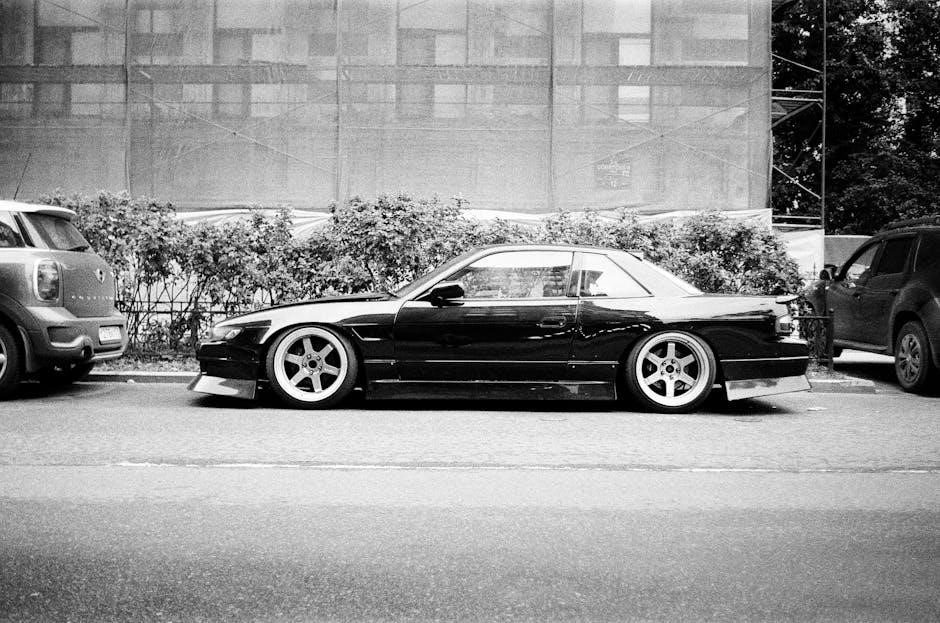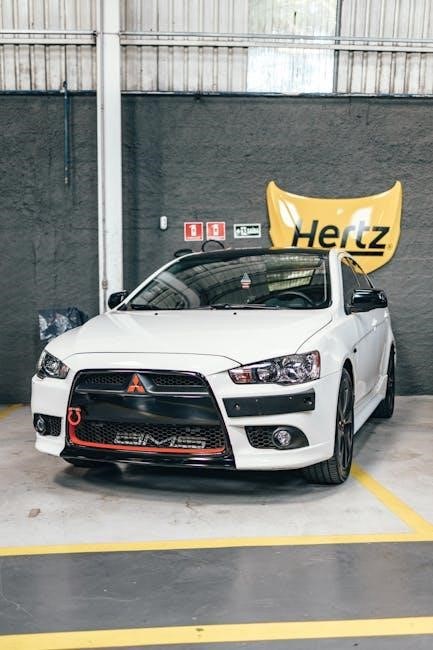Aftermarket wheels are custom rims designed to replace standard wheels, offering enhanced style, performance, and personalization for vehicles. They provide a cost-effective way to upgrade aesthetics and functionality.
1.1 What Are Aftermarket Wheels?
Aftermarket wheels are custom-designed rims manufactured by third-party companies to replace a vehicle’s original wheels. They offer unique styles, improved performance, and personalization options. Unlike OEM wheels, aftermarket wheels are tailored to individual preferences, enhancing aesthetics and functionality while maintaining safety and compatibility with the vehicle’s specifications.
1.2 Benefits of Upgrading to Aftermarket Wheels
Upgrading to aftermarket wheels enhances your vehicle’s appearance, offering a personalized style that reflects your taste. They can improve handling and braking performance while allowing for larger tire upgrades. Additionally, aftermarket wheels are often more durable than stock rims and can increase your vehicle’s resale value. This upgrade is a popular choice for car enthusiasts seeking both functionality and visual appeal.

Understanding Wheel Sizes and Fitments
Understanding wheel sizes and fitments ensures compatibility with your vehicle, improving performance and safety. Proper sizing maintains handling and prevents issues like rubbing or instability while driving.
2.1 How to Measure Wheel Size
Measuring wheel size involves determining the diameter, width, and bolt pattern. Start by checking the rim for markings indicating size, such as 17×7.5, which stands for 17-inch diameter and 7.5-inch width. Use a ruler or tape measure if markings are unclear. Always ensure accurate measurements to maintain proper fitment and performance for your vehicle.
2.2 Importance of Proper Fitment for Your Vehicle
Proper fitment ensures safety, optimal performance, and prevents damage. Incorrectly sized wheels can rub against fenders or suspension, causing wear and tear. Proper fitment maintains handling stability, especially at higher speeds, and avoids uneven tire wear. Always verify measurements and compatibility to ensure a smooth, safe driving experience and maximize the lifespan of both wheels and tires.
Materials Used in Aftermarket Wheels
Aftermarket wheels are crafted from materials like aluminum, known for its lightweight and corrosion resistance, and steel, offering durability and cost-effectiveness, each with unique advantages.
3.1 Aluminum Wheels: Advantages and Disadvantages
Aluminum wheels are popular for their lightweight design, improving fuel efficiency and handling. They resist corrosion and offer a sleek appearance. However, they can bend under heavy stress and are more expensive than steel wheels, making them less durable in extreme conditions.
3.2 Steel Wheels: Durability and Cost-Effectiveness
Steel wheels are renowned for their robustness and affordability, making them a practical choice for everyday use. They are less prone to bending than aluminum wheels and offer excellent strength, perfect for heavy-duty applications. However, they are heavier, which can affect performance, and lack the aesthetic appeal of aluminum rims.
Bolt Patterns and Offset
Bolt patterns and offset are critical for proper wheel fitment. Bolt patterns determine how wheels attach to hubs, while offset affects spacing and alignment, ensuring stability.
4.1 How to Determine Your Vehicle’s Bolt Pattern
To determine your vehicle’s bolt pattern, count the number of bolts and measure the distance between two opposite bolts. Common patterns include 4x100mm or 5×114.3mm. Use a tape measure or ruler to ensure accuracy. Consult your owner’s manual or manufacturer’s website for specifications. Proper alignment with your vehicle’s hub is essential for safe and secure wheel installation.
4.2 Understanding Wheel Offset and Its Impact on Fitment
Wheel offset is the distance from the centerline to the mounting face. A positive offset moves the wheel outward, while a negative offset pulls it inward. Incorrect offset can cause rubbing or poor handling. Always match the offset to your vehicle’s specifications for proper fitment and optimal performance. Ensure compatibility before purchasing aftermarket wheels to avoid installation issues.
Wheel Finishes and Designs

Aftermarket wheels come in various finishes like chrome, black, and machined, offering sleek aesthetics. Designs range from sporty to elegant, allowing drivers to customize their vehicle’s appearance effortlessly.
5.1 Popular Finishes: Chrome, Black, Machined, and More
Chrome finishes offer a shiny, reflective look, while black wheels provide a sleek, modern appearance. Machined finishes combine polished and brushed elements for a sophisticated style. Additional options like gloss, matte, and custom colors allow drivers to match their vehicle’s personality, ensuring a unique and personalized look that enhances overall aesthetics and performance.
5.2 Choosing a Design That Matches Your Vehicle’s Style
Selecting the right wheel design involves considering your vehicle’s make, model, and personal taste. For sports cars, bold, aerodynamic designs enhance performance aesthetics, while SUVs benefit from rugged, off-road-inspired styles. Classic cars may prefer timeless, vintage patterns. Ensure the design complements your vehicle’s lines and overall appearance for a cohesive, polished look that reflects your unique style and driving preferences.

Tires and Wheels: Compatibility and Performance
Proper tire and wheel pairing is crucial for optimal vehicle performance, safety, and handling. Compatibility ensures balanced traction, while incorrect sizing can lead to reduced efficiency and safety risks.
6.1 How to Pair Tires with Your Aftermarket Wheels
Pairing tires with aftermarket wheels requires matching the tire size to the wheel diameter and ensuring the load rating and speed rating align with your vehicle’s specifications. Always check the tread pattern to suit your driving conditions, such as highway, off-road, or winter driving. Consult a professional or use compatibility charts to ensure a proper fit and optimal performance.

6.2 Impact of Wheel Up-sizing on Tires
Up-sizing wheels can affect tire performance by altering speedometer accuracy and reducing sidewall height, potentially compromising ride comfort. Larger wheels may require lower profile tires, which can increase risk of damage from potholes. Ensure proper tire fitment by consulting a professional to maintain safety and vehicle handling, as incorrect sizing can lead to decreased traction and stability.

Upsizing or Downsizing Wheels
Upsizing or downsizing wheels can significantly impact a vehicle’s performance, aesthetics, and functionality. It involves selecting wheels larger or smaller than the original equipment, requiring careful consideration of fitment, tire compatibility, and suspension clearance to ensure optimal performance and safety. Proper sizing enhances both style and driving dynamics, avoiding potential issues like reduced traction or compromised handling. Always consult a professional to ensure correct installation and compatibility, as improper sizing can lead to mechanical problems and safety hazards. Additionally, upsizing may improve stability at high speeds, while downsizing can offer better maneuverability in tight spaces, making it a balance between form and function. Ultimately, the decision should align with the vehicle’s intended use and the owner’s preferences for appearance and performance. By understanding the pros and cons of each option, drivers can make informed choices that enhance their driving experience without compromising safety or functionality.
7.1 Pros and Cons of Larger Wheels
Larger wheels enhance vehicle aesthetics and improve handling by increasing stability at higher speeds. They also provide better braking performance due to larger brake rotor compatibility. However, they can decrease fuel efficiency, ride comfort, and increase costs. Larger wheels may require more expensive tires and can exacerbate road imperfections, making the ride harsher. Additionally, they may not fit smaller garages or parking spaces, requiring careful measurement and consideration of vehicle clearance to avoid scraping or damage. Furthermore, oversized wheels can lead to inaccurate speedometer readings if not properly calibrated, potentially affecting vehicle safety. It is crucial to weigh these factors against the desired visual and performance benefits to ensure they align with the vehicle’s intended use and driving conditions. Proper fitment and compatibility are essential to avoid mechanical issues and maintain optimal performance, making professional consultation advisable before upgrading. Balancing style with functionality is key to a successful wheel upgrade, ensuring both form and function meet the driver’s expectations without compromising safety or comfort.
7.2 When to Consider Smaller Wheels
Smaller wheels are ideal for vehicles prioritizing practicality, offering better fuel efficiency, lower costs, and smoother rides. They are suitable for city driving, older vehicles, or rough terrain. Smaller wheels also improve maneuverability in tight spaces and reduce tire replacement expenses. However, they may compromise on style and performance compared to larger wheels. They are a sensible choice for drivers seeking reliability and affordability without sacrificing safety or comfort;

Safety and Durability Considerations
Safety and durability are crucial when selecting aftermarket wheels. Ensure wheels meet load ratings and are constructed from high-quality materials. Manufacturer warranties often guarantee reliability and longevity.
8.1 Load Rating: Ensuring Your Wheels Can Handle the Weight
Load rating is a critical factor in selecting aftermarket wheels. It determines the maximum weight the wheels can safely support. Always choose wheels with a load rating that matches or exceeds your vehicle’s Gross Vehicle Weight Rating (GVWR). This ensures stability and prevents potential damage or failure while driving. Proper load rating is essential for safety and durability.
8.2 Warranty and Quality of Aftermarket Wheels
Reputable brands offer warranties on aftermarket wheels, typically ranging from 1 to 5 years. These warranties often cover manufacturing defects, ensuring quality and durability. High-quality wheels are constructed from durable materials and advanced manufacturing processes, providing long-lasting performance and aesthetic appeal. Always research the manufacturer’s reputation and warranty terms before making a purchase to ensure reliability and satisfaction.

Installation and Maintenance Tips
Proper installation ensures safety and performance. Tighten lug nuts in a star pattern and torque to specifications. Regularly clean wheels to prevent corrosion and maintain appearance.
9.1 DIY Installation Guide
Installing aftermarket wheels requires careful preparation and attention to detail. Start by loosening lug nuts with the vehicle on the ground, then lift safely using jack stands. Remove the original wheels and inspect the hubs. Mount the new wheels, ensuring proper alignment and torque specifications. Tighten lug nuts in a star pattern for even pressure. Double-check all connections before driving.
- Always refer to your vehicle’s manual for specific instructions.
- Use a torque wrench to avoid over-tightening.
- Test drive slowly to ensure stability and proper fitment.
9.2 Caring for Your Aftermarket Wheels
Regular maintenance ensures your aftermarket wheels remain in pristine condition. Clean them with mild soap and water, avoiding harsh chemicals or abrasive materials. Apply a protective wax or sealant to prevent corrosion. Inspect for damage or wear regularly, addressing issues promptly. Avoid extreme temperatures and road hazards to maintain their finish and structural integrity.
- Use a soft brush for detailed cleaning.
- Avoid washing in direct sunlight to prevent spotting.
- Inspect bolts and nuts for tightness periodically.
Buyer’s Guide
When purchasing aftermarket wheels, prioritize compatibility, quality, and warranty. Choose reputable brands, verify load ratings, and ensure proper fitment for your vehicle. Always consult experts or reviews before buying.
- Check compatibility with your vehicle’s make and model.
- Consider your driving habits and budget.
- Look for certifications and customer support.
10.1 Top Brands to Consider
Leading aftermarket wheel brands include Enkei, BBS, and RAYS, known for their durability, performance, and stylish designs. These brands offer a wide range of options to suit various vehicle types and preferences, ensuring both aesthetic appeal and enhanced functionality. Researching these brands can help you find the perfect fit for your car.
10.2 Where to Buy Aftermarket Wheels
Aftermarket wheels can be purchased from reputable retailers like Tire Rack, Discount Tire, and Amazon. Specialty shops and online marketplaces also offer a wide selection. Ensure to check for compatibility and reviews before buying. Local auto shops may carry popular brands or order custom wheels for you, ensuring proper fitment and quality.
Aftermarket wheels enhance both aesthetics and performance, offering customization and improved driving experiences. Always prioritize compatibility and quality to ensure safety and satisfaction with your upgrade.
11.1 Final Tips for Choosing the Right Aftermarket Wheels
When selecting aftermarket wheels, consider your vehicle’s make, model, and intended use. Ensure compatibility with your car’s bolt pattern and load rating. Choose a style that matches your vehicle’s aesthetics and personal preferences. Opt for reputable brands to guarantee quality and durability. Check reviews, seek recommendations, and consider future maintenance costs to make an informed decision.
11.2 The Future of Aftermarket Wheel Technology
The future of aftermarket wheel technology lies in lightweight materials, advanced manufacturing techniques, and sustainable designs. Forged aluminum and carbon fiber wheels are expected to dominate, offering superior strength-to-weight ratios. Aerodynamic designs will improve fuel efficiency, while smart wheels with integrated sensors may become standard. Eco-friendly production methods and customizable 3D-printed wheels are also on the horizon, promising innovation and personalization for enthusiasts.